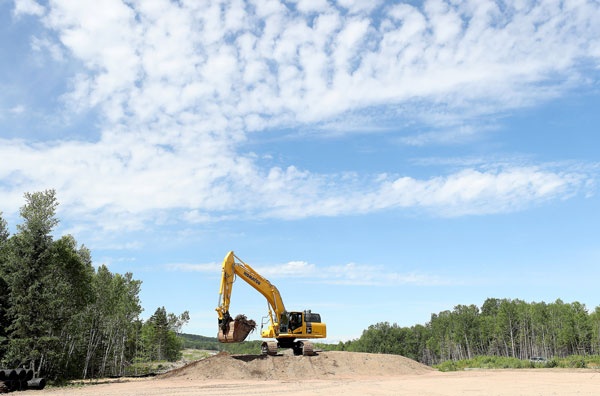Roadbuilding crews have started working on one of the largest and most expensive infrastructure projects in the history of Nova Scotia, a $718-million twinning of Highway 104 from Sutherlands River east of New Glasgow to Antigonish.
The project will take close to three years and entails building 28 kilometres of new two-lane twinned highway and 10 kilometres of new four-lane twinned highway. There are two interchanges and 24 new bridges planned along the route which is part of the Trans-Canada Highway.
Crews are now working on the first phase of the project between Antigonish and James River, which involves cutting and putting down a new roadbed and surface and building infrastructure.
Dexter Nova Alliance, led by local contractors Dexter Construction and Nova Construction, with BBGI as an equity partner, won the bid for the project last May after an extensive procurement and bidding process.
The province is using a P3 model which transfers the responsibility for designing, building, financing, operating and maintaining (DBFOM) the highway for 20 years to Dexter Nova Alliance. Ownership will remain with the province but the alliance will be responsible for repairing potholes, repaving and snow removal.
The highway is the province’s most important transportation corridor but is also one of the deadliest, as there have been 391 collisions, including 19 fatalities, on the un-twinned portion of the highway since 2009.
“It’s been a dangerous stretch of highway for a long period of time, so it’s really a safety concern and that’s one of the reasons that this alternative procurement method was selected for this project.” says Bradley Cleary, P3 construction and operations manager for Nova Scotia, on the project.
“We really wanted to expediate the construction and the design, build, finance, operate and maintain model was a fast way of getting the work done compared to our traditional methods. We are going to get it built quicker and we can have a safer highway for the people of Nova Scotia.”

The pricetag for the project includes $364.3 million for construction and $196.4 million for ongoing operations and maintenance and a major upgrade of the existing stretch of highway during the 20-year operating period. Insurance, professional fees, financing and other costs make up the remainder.
The federal government is contributing $90 million to the project under the National Trade Corridors Fund.
The project has been in the works since 2015 when a review was done and it was determined that the province should look at twinning a number of its 100-series highways to make them safer. A feasibility study was done and, after receiving input from the public, the province chose a route and P3 model for the venture.
While there were varying P3 models to choose from, the province selected the DBFOM approach and, in July 2018, pared the number to three preferrered bidders. An RFP was issued in early 2019 and the Dexter Nova Alliance was announced as the winner.
The plan is for crews to build the twinned portion of highway then flip traffic to that segment while repairing and repaving the original section. Once finished, all lanes on both segments will be opened to traffic.
A tricky part of the route will be a 10-kilometre stretch between Barneys River Station and James River where there are large hills. A new highway is being built over the hills to the south of the existing roadway.
The Government of Nova Scotia is trying to minimize the impact of the new build on wildlife such as moose, deer and turtles.
“This project is going to have more features for accommodating wildlife than any project we’ve built in the province before,” notes Cleary. “We’re going to have three primary mammal crossings. In places where there’s bridges over water, we’ll make sure that the deer don’t have to go up on the road. They can go underneath the bridge.”
One of the structures will be built larger to accommodate moose, so that when the animal looks inside it knows it won’t hit its head. Otherwise, the moose won’t cross.
Equally important, when installing crossings 25 metres of fencing and tree cover will be set in place. Animals like deer and moose will typically walk along the tree cover because they don’t want to be seen.
“They don’t like to go out in the open, so they stay in the trees and they’ll walk and they’ll follow the trees,” says Cleary.
Predictably, COVID-19 has caused some headaches for the general contractors. To overcome the challenges, the alliance has adjusted and continued with a daily hygiene checklist onsite to ensure equipment is sanitized. Masks are enforced when social distancing isn’t possible and hand sanitization stations are available.
Ken MacLean, vice-president of Dexter Nova Alliance, says he is pleased that the long-anticipated project is underway.
“This is a significant project that will have a positive impact on our province for decades to come. It will be built by Nova Scotia-based companies for Nova Scotians and we are proud of that.”









Recent Comments